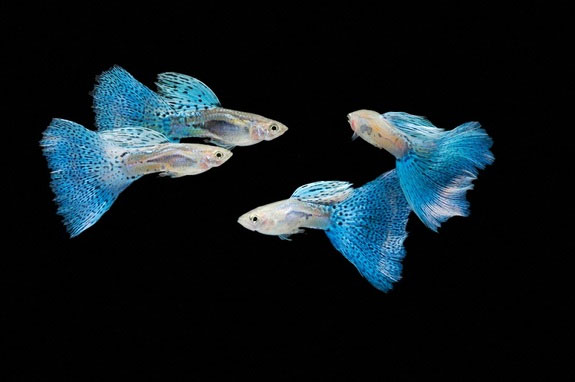Are guppies more carnivorous than tigers and sharks?
As a result of a new chemical analysis, Poecilia reticulata is placed high in the food chain, even standing on a shark.
>>>See guppies laying babies
Analysis by Purdue University Associate Professor (United States), Mr. Greg Michalski is based on the analysis of different nitrogen atoms, known as the accumulated nitrogen isotopes in species. The heavier nitrogen isotopes - nitrogen 15 (15N) - accumulate gradually in the food chain because the animal body normally excretes lighter forms - nitrogen 14 (14N), retaining ni- Heavy silk from animals that eat meat.

Poecilia reticulata Guppies
According to each level increasing in the food chain, the change of the heavy / light nitrogen ratio will change in the direction that the 15N nitrogen isotopes will prevail. Therefore, a plant will have the lowest nitrogen levels, and a top carnivore, such as sharks or tigers, will have the highest levels of nitrogen.
After examining his seafood with his students, Mr. Greg Michalski found that the filtering animals, like mussels, showed a relatively low level of 15N, while the fish species ranked first in the food chain, such as Tuna and swordfish are the species with the highest level of 15N.
But, even more surprising, is the popular freshwater fish Poecilia reticulata - because their bodies exhibit unprecedentedly high levels of nitrogen. In particular, in the body of guppies, it has measured the number of nitrogen isotopes weighing 0.149% higher than the heavy / light nitrogen ratio in the air, exceeding the nitrogen enrichment ratio of Thresher shark species (0.143%).
The reason lies in their own food source , explains Greg Michalski. Guppies for food are usually crushed and pressed flakes, produced from commercial fish waste products such as head, intestines, fish fins . which contain heavy nitrogen isotopes. So, when the guppies eat the food, they will accumulate more and more heavy isotopes and climb to the top position in the food chain.
- Watch guppies laying babies
- Sharks eat more grass than meat makes the science world confused
- How are predatory tigers?
- Giant white sharks eat more than people think
- Guppies can destroy the natural ecological environment
- The fiends in the shark world
- The Lord of the Forest is around the world
- Compare the size of shark species in the world
- White sharks have their heads torn
- What if you fall into an area full of sharks?
- Extremely hidden carnivorous plants
- Whether or not Man-Eating Tree?
 Surprised: Fish that live in the dark ocean still see colors
Surprised: Fish that live in the dark ocean still see colors Japan suddenly caught the creature that caused the earthquake in the legend
Japan suddenly caught the creature that caused the earthquake in the legend A series of gray whale carcasses washed ashore on California's coast
A series of gray whale carcasses washed ashore on California's coast Compare the size of shark species in the world
Compare the size of shark species in the world